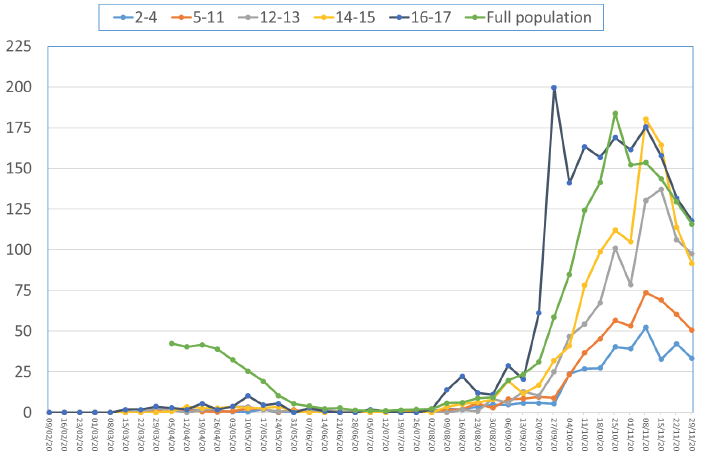Working Paper: Covid-19 Mitigation Measures Among Children and Young People
Summary of Scottish evidence on the COVID-19 mitigation measures aimed at children and young people
2. Transmission of Covid-19 among children and young people in Scotland
A recent summary report prepared for the Coronavirus (Covid-19): Advisory Sub-Group on Education and Children's Issues[1]provides an overview of the Scottish and UK evidence regarding the interactions between Covid-19 and school / early learning and childcare (ELC) settings. This includes the role of children in transmission of Covid-19 to other children and to adults; workplace-associated risks to school staff from Covid-19; the approach to reducing risks in schools; and data on attendance and absences.
Key relevant messages from the report are:
- Pre-school and primary school aged children are less susceptible to infection from COVID-19 than adults. The evidence is more mixed for secondary aged young people. There continues to be strong evidence that children and younger people are much less susceptible to severe clinical Covid-19 disease than older people.
- The risk of transmission from children to children and children to adults in primary school and ELC settings appears low, particularly when effective infection control measures are in place.
- In Scotland, as in other countries, the 'second wave' has a different profile to the first, with a much higher prevalence among children and young adults. While this may indicate a potential role of school reopening as a factor, the extent to which there has been transmission within schools is difficult to establish.
- Transmission can occur in household, community and educational settings. It is difficult to separate the risk of infection as the result of behaviour outside schools from the risks arising from in-school contacts. For children, these wider contacts include journeys to and from school, and other activities and gatherings.
- There is no current direct evidence that transmission within schools plays a significant contributory role in driving increased rates of infection among children, but neither is there direct evidence to suggest otherwise. The role of children in transmission remains relatively less well understood, and asymptomatic transmission is particularly problematic to analyse.
- ONS data shows no evidence of any difference between the test positivity rates of pre-school, primary and secondary school teachers and staff, relative to other worker groups of a similar age. The proportion of positive test cases from people aged 18+ who reported they were employed and their occupation was "education/childcare" has remained largely constant since late August at between 3 and 7%.
- International comparators suggest that there is no consistent pattern of relationship between the reopening of schools and increases in case numbers.
- The Coronavirus (COVID-19): guidance on reducing risks in schools published by Scottish Government sets out non-statutory guidance to ensure a safe and supportive environment for learning and teaching during the pandemic.
- There is clear evidence that time out of school has a detrimental effect on children and young people's wellbeing, including impacts on developmental and mental health harms. Evidence suggests that the mental health of adolescents is particularly affected. These detrimental effects are particularly prevalent for vulnerable children and young people. School closures put educational outcomes at risk, especially for vulnerable children and young people. COVID-19 increases educational and social inequities for children and young people; this is a key reason for keeping schools open.
In November, Public Health Scotland also published an analysis of Scottish Covid-19 test data for children aged 4 to 17 during the period term 1 of the 2019/20 school year, linked to CHSP-School records to identify the school the child went to[2]. In addition, statistics on test data for children and young people up to the age of 17, as well as covid-19-related pupil absences, are published weekly[3]. Please note this analysis identifies pupils that have taken a Covid-19 test only, and it is not possible to draw conclusions about asymptomatic cases.
The weekly rate of positive cases per 100,000 pupils and the number of schools with pupils testing positive remained largely stable for the first five weeks of Term 1, with increases from the week commencing 21 September. Among 16-17 year olds the rate peaked at the end of September and has fluctuated at a fairly steady level since, while for younger age groups the increase was more gradual to peaks in early and mid November. Rates in all age groups fell between the middle and end of November. See Figure 1 below.

Source: COVID-19 Education Recovery Group: children and young people infographic, 10 December
Contact
Email: socialresearch@gov.scot
There is a problem
Thanks for your feedback